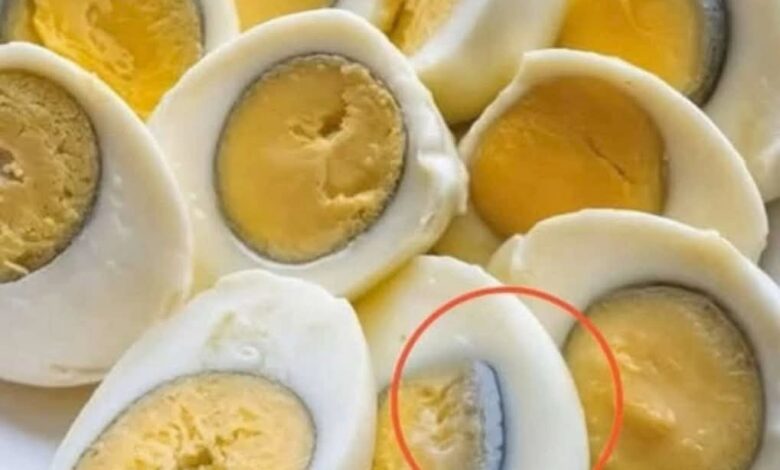Origin and Cultural Significance

Absolutely! Here’s a fully detailed breakdown of the phenomenon of the green ring around an egg yolk — a common kitchen curiosity with both science and practical advice behind it.
—
🍳 Introduction
You’ve just hard-boiled some eggs, peeled them, sliced one open — and then you see it: a greenish-gray ring around the yolk. Is it spoiled? Unsafe to eat? Not at all! Let’s unpack exactly what it means and how to avoid it.
—
🥚
Hard-boiled eggs are a staple across cultures — from deviled eggs in the U.S., to soy-marinated eggs in East Asia, to the humble boiled egg in European breakfasts. Regardless of where or how they’re enjoyed, properly cooked eggs are a small but essential part of many traditional meals.
So, when something doesn’t look “right,” like that green ring, it naturally raises concern. But this discoloration has a scientific explanation — and no cultural taboo. In fact, it’s so common that chefs, food scientists, and even home cooks pass down methods to prevent it.
—
📏 Ingredients & Quantities (for Perfect Hard-Boiled Eggs)
To make 6 hard-boiled eggs, you’ll need:
6 large eggs
Water (enough to cover eggs by 1 inch in the pot)
1 tsp vinegar (optional) – helps with easier peeling
1 tsp salt (optional) – can help prevent cracking
—
🧪 Optional Additions (for better texture and peel)
Ice (for an ice bath post-cooking)
Baking soda – a pinch added to the water may make peeling easier, especially for fresh eggs
—
💡 Tips for Success (Avoiding the Green Ring)
The greenish ring is caused by a chemical reaction between sulfur in the egg white and iron in the yolk. When overcooked, they react to form ferrous sulfide, which has that green-gray hue.
To avoid this:
Don’t overcook: Boil eggs gently and time it precisely.
Cool rapidly: Use an ice bath right after boiling to stop the cooking process.
Use an appropriate method: See instructions below.
—
🧾 Instructions (Perfect Hard-Boiled Eggs Without the Green Ring)
Method:
1. Place eggs in a saucepan in a single layer.
2. Cover with cold water, 1 inch above eggs.
3. Add optional vinegar/salt if desired.
4. Bring water to a gentle boil over medium heat.
5. Once boiling, remove from heat and cover the pot.
6. Let eggs sit in hot water for 9–12 minutes:
9 minutes = creamier yolk
12 minutes = fully cooked yolk
7. Immediately transfer eggs to an ice water bath.
8. Let cool for at least 5–10 minutes before peeling.
—
✨ Description
When done right, the yolk is a vibrant yellow, with no green or gray discoloration. The white is firm but tender, and the egg peels easily thanks to the shocking in cold water.
The green ring, while harmless, tends to dry out the texture and make the egg less visually appealing.
—
🔬 Nutritional Information (per large hard-boiled egg)
Calories: 70
Protein: 6g
Fat: 5g
Carbohydrates: <1g
Cholesterol: 185mg
Rich in: Vitamin B12, Selenium, Riboflavin
The green ring does not affect nutritional value — it’s purely aesthetic and textural.
—
✅ Conclusion
So, what does the green ring mean? In short: overcooked, but still safe to eat. It’s a simple kitchen chemistry issue, easily fixed with the right cooking method and some cool-down time.
—
👍 Recommendation
If you’re meal-prepping, making deviled eggs, or hosting a brunch, aim for yolks with a clean yellow color — they look and taste better. But if you do end up with green-ringed yolks? Chop them into salads or mash into egg salad — they’re perfectly fine to eat.
—
💚 Embracing Healthful Indulgence
Hard-boiled eggs are a fantastic, portable, protein-rich snack. Keep a few in the fridge each week. They’re satisfying, support muscle repair, and help curb cravings. And by mastering the perfect cook time, you’re turning a humble egg into a delicious, healthful indulgence.
—
💬 When you see a green ring around an egg yolk, it’s a sign that…
…the egg has been overcooked — but it’s still safe and nutritious to eat! For creamier yolks, just follow the tips above and never skip the ice bath. ❄️🥚✨
Would you like a visual cooking guide or printable recipe card for this?


